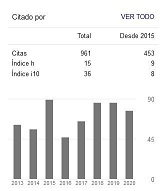Evaluación de la actividad del Albendazol y el Triclabendazol en rebaños de ovinos infectados por Fasciola hepatica.
Resumen
Se evaluó la acción del Albendazol y el Triclabendazol en 12 ovinos adultos de raza Pelibuey infectados por Fasciola hepatica, en la provincia de Camagüey, Cuba. Se empleó de un test de reducción y conteo de huevos en las heces (HPG). Para el estudio crítico se distribuyeron los animales en 2 grupos. En el día 0 (D0) los animales del grupo 1 recibieron Albendazol vía oral y los del grupo 2 Triclabendazol. Se colectaron las muestras de heces (vía retal) los días 0 (D0), 14 (D14) y 28 (D28) después del tratamiento. Para el conteo de huevos de F. hepatica se empleó la técnica de McMaster, con una solución de ZnCl2 (1,5 g/ml) a una sensibilidad de 10 huevos por gramos de heces. Se calculó la media de los resultados por grupo y, posterior-mente, el por ciento de reducción de huevos. El D14 se observó 98,17 % de reducción de huevos para el grupo 1 y 79,58 % para el grupo 2; sin embargo, en el D28 el grupo 1 alcanzó 33 % de reducción de huevos, mientras que el grupo 2 alcanzó 90,39 %. El tratamiento con Triclabendozol se mostró más efectivo para F. hepatica.
Albendazol and Triclabendazol as Treatment for Fasciolosis in Sheep
ABSTRACT
The aim of this study was to evaluate the activity of Albendazole (ABZ) and Triclabendazole (TBZ) in a sheep flock naturally infected with F. hepatica. The faecal egg count reduction test (HPG) was used in 12 adult sheep in a farm located in Camagüey province, Cuba. The animals were distributed into two treated groups (ABZ=G1 and TBZ=G2: critical study) and at day 0 received an oral dose of each drug. Stool samples were collected at 0, 14 and 28 days after treatment. The modified McMaster technique was used with ZnSO4 solution at 1.5 g/mL having an analytic sensitivity of 10 eggs per gram of faeces. We observed 98.17 and 79.58 % egg reduction at day 14 for G1 and G2, respectively. At day 28, G1 showed only 33.94 %, while G2 demonstrated 90.39 % of eggs reduction. G2 provided more time of F. hepatica egg reduction than G1. We may justify the high efficacy of TBZ by its exclusive action against juvenile and adult stages of F. hepatica. We also report the lack of efficacy and persistency of action of ABZ against F. hepatica being a risk in the control of the parasite and the maintenance of animal welfare.
Descargas
Citas
FAIRWEATHER, I. (2005). Triclabendazole: New Skills to Unravel an Old(ish) Enigma. J Helminthol., 79 (3), 27-34.
FAIRWEATHER, I. (2011). La reducción de la amenaza futura a partir de (hígado) golpe de suerte: realista perspectiva o de fantasía quijotesca. Vet. Parasitol., 180, 133-143.
FLANAGAN, A. M.; EDGAR, W. J.; FORSTER, F.; GORDON, A.; HANNA, E. B.; FLANAGAN, A.; EDGAR, W. J. et al. (2011). Anthelmintic Activity of Artesunate against Fasciola hepatica in Naturally Infected Sheep. Veterinary Science, 88, 107-110.
LYONS, E. T., TOLLIVER, S. C.; DRUDGE, J. H.; STAMPER, S.; SWERCZEK, T. W.; GRANSTROM, D. E. (1992). Critical Test Evaluation (1977–1992) of Drug Efficacy against Endoparasites Featuring Benzimidazole-Resistant Small Strongyles (Population S) in Shetland Ponies.
MAS-COMA, S. (2005). Epidemiology of Fascioliasis in Sheep Endemic Areas. J. Helminthol.,79, 207-216.
MEZO, M.; GONZÁLEZ-WARLETA, M.; CARRO, C.; UBEIRA, F. M. (2004). Un ultrasensible ELISA de captura para la detección de coproantígenos de Fasciola hepatica en ovejas y el ganado con un nuevo anticuerpo monoclonal (MM3). J. Parasitol., 90, 845-852.
REINALDO, L.; PÉREZ RUANO, M.; BRITO. S. (2002). Fasciolose Bovine a Cuba. Etude Rétrospective a L´abatage et Analyse des Perdes par Saiseie de Folies. Revue Élev. Méd. Vét. Pays trop., 55, 31-34.
ORTIZ, P.; CERNA, C.; ROSALES, C.; CABRERA, M.; SOLANA, H. D.; SCARCELLA, S., LAMENZA, P.; VILLEGAS, F. et al. (2012). Administration of Triclabendazole is Safe and Effective in Controlling Fascioliasis in an Endemic Community of the Bolivian Altiplano. PLoS Negl Trop Dis, 6 (8), 1 720-2 012.
GONZÁLEZ, J. E. (1995). Evaluación económica de la Fasciolosis en la provincia Sancti Spíritus y valoración económica de las pérdidas ocasionadas. IV Congreso Nacional de Ciencias Veterinarias. La Habana, Cuba.
BORAY, J. C. (1997). Chemotherapy of Infections with Fasciolidae. Immunology, Pathobiology and Control of Fasciolosis. Rahway, NJ: MSD AGVET.
LAVERDE L. (2007). Efecto del nosodes fasciolinum y del fármaco Triclabendazol sobre la oviposición de Fasciola hepática en bovinos. Tesis de Maestría. Facultad de Ciencias Veterinarias, Univ. Austral de Chile, Valdivia.
LEATHWICK, D.; MILLER, C.; ATKINSON, D.; HAACK, N.; ALEXANDER, R.; OLIVER, A. M.; WAGHORN, T.; POTTER, J.; SUTHERLAND, I. (2006). Drenching Adult Ewes: Implications of Anthelmintic Treatments Pre- and Post-Lambing on the Development of Anthelmintic Resistance. NZ Vet. J., 54, 297-
304.
MOLL, L.; GAASENBEEK, G.; VELLEMA, P.; BORGSTEEDE, F. (2000). Resistence of Fasciola Hepatica against Tricla-bendazole in Cattle and Sheep in Netherlands. Vet. Parasitol., 91, 153-158.
OVEREND, D.; BOWEN, F. (1995). Resistance of Fasciola Hepatica to Triclabendazole. Austr. Vet. J., 72, 275-276.
Los autores de los artículos publicados en RPA retienen los derechos de autor de su trabajo, de marca y patente, y también sobre cualquier proceso o procedimiento descrito en el artículo, así como a compartir, copiar, distribuir, ejecutar y comunicar públicamente el artículo publicado en la RPA o cualquier parte de aquel siempre que indiquen la fuente de publicación (autores del trabajo, revista, volumen, número y fecha), pero están de acuerdo en que la revista publique los trabajos bajo una licencia Creative Commons.
![]() Licencia Attribution-NonCommercial 4.0 International (CC BY-NC 4.0)
Licencia Attribution-NonCommercial 4.0 International (CC BY-NC 4.0)






































